Captain Sindbad (1963)
Directed by: Byron Haskin
Written by: Guy Endore, Ian McLellan Hunter
Starring: Abraham Sofaer, Guy Williams, Heidi Brühl, Pedro Armendáriz
USA/WEST GERMANY
AVAILABLE ON: Region 1 DVD and Digital
RUNNING TIME: 85 mins
REVIEWED BY: Dr Lenera
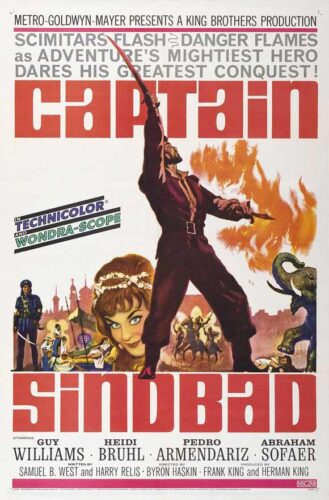
The kingdom of Baristan is ruled by the evil El Kerim with an iron fist. He’s intent on marrying Princess Jana, whose father was the king before being deposed by El Kerim, but Jana is betrothed to Sindbad, who’s just returning from a lengthy voyage to marry her. So he prepares to capture Sindbad, but Jana convinces Galgo the magician to turn her into a Firebird, so that she may fly off to warn Sindbad of the trap set for him. But before she can deliver the message, she’s captured and Sindbad’s shop is sunk by rocks thrown by some of El Kerim’s men who’ve been turned into large falcons. Sindbad and a few others survive, and set out to rescue Jana and kill El Kerim, but how do you kill somebody who seemingly cannot be killed?
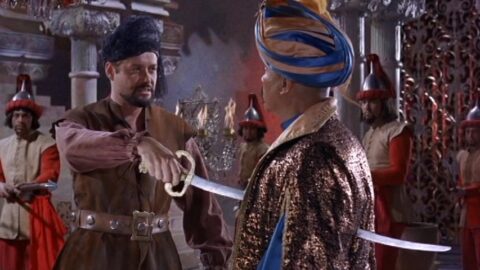
I distinctly remember when this was in TV; I was about 12 and for some reason I wasn’t able to watch it. Boo! I don’t think it’s been on UK TV since, but as I watched it slight, vague flashbacks enter my head, meaning that it must have shown some time before and that I actually had seen it and at a very young age indeed. Then it appeared, something that I’d remembered for so long but couldn’t find out in which film it belonged. What am I talking about? I’m talking about The Hand. A giant gloved hand with spikes on which is one of the very last of the countless perils that Sindbad [spelt more faithfully here] faces. It’s such a peculiar menace that it’s no wonder that it stuck so much in my mind. Captain Sindbad would have been worth watching just for that, but thankfully it also turned out to be a rather delightful fantasy that has a real fairytale-like feel lacking in the much better known Ray Harryhausen productions, a better script [even if it does imitate The Thief Of Bagdad a fair bit], and a lighter tone too without quite lapsing into parody. Sounds like a neglected classic, aye? Well it’s held back somewhat by the very low budget which clearly was considerably inadequate for the myriad of special effects required. Some of them are pretty good, and there’s a case for saying that the unreality of many of the sights and settings adds to the atmosphere, but some seem only half-achieved and a few visuals are poorly done even for the time; an early sequence set on Sindbad’s ship has some of the worst matting of actors I’ve ever seen from the period. But let’s try not to complain too much about this sort of thing, because a heck of a lot of fun is packed into this movie which soars in its final act where things almost attain the phantasmagoric. I wonder if its relative obscurity can be partly put down to the fact that in the US it was released on the same day as Jason And The Argonauts which understandably took all the attention?
There seems to be little information about Captain Sindbad except that the German-American production was initially intended to be a more expensive picture but had to be rewritten by co-producer Frank King a week before shooting commenced to accommodate the reduced budget. This seems evident when you watch it; it looks like certain scenes were originally conceptually more ambitious, not to mention the extreme economy of the use of sets. After the opening streets of Buristan, we cut to the main throne hall which is a rather vague place; it appears to be an open air affair, with walls that only reach so high except on one side where some towers seems to be on top of several walls. The set looks unfinished and the palace is obviously a small model, yet this is a good example of the air of unreality which is caused by the shortage of funds available. Our first main character who we see is Galgo the wizard, introduced trying to make a plant come to life but actually causing havoc all over with the growing lightning-striking cloud he creates. Galgo bumbles and whines throughout, Abraham Sofaer hamming it up immensely. The comic relief character gets a little tiresome but it’s not as if he has that many scenes. It’s amusing to wonder if Galgo’s cloud, which we last see going into the sea, is what causes the storm which hits Sindbad’s ship. His beloved Jana wants to tell him of the danger which awaits him in Baristan, but gets embarrassed when she has to get naked in order to be shrunk and then turned into a bird. “There are three men before a woman should have no shame; her husband, her doctor and her magician” says Galgo in the line that will probably most stick in my mind from this film. Jana reaches Sindbad but then along come some big falcons who turn into men when killed. The mixture of grainy model bird footage and very clear [on the DVD] material on the ship doesn’t make for the most thrilling set piece, and then there’s that glaringly cheap-looking blue background during most of the ship scenes.
However, the rest of the film is set on land, which is odd for a Sindbad film but is where things improve quite considerably. Sindbad decides to pose as a petty thief so he can be arrested and confront El Kerim as well as see Jana. Their love story is emphasised a little bit more than it would have been if this was one of the Harryhausen/ Charles H. Schneer Sinbads, the writers of which knew that such material comprised “the boring bits” for kids, though our couple are rarely actually seen together. There’s a rather intense scene where El Kerim orders Sindbad to be whipped right in front of Jana. El Kerim and Sindbad have never met before and Jana doesn’t want to give Sindbad away, but she can’t stand the violence and cries out his name, whereupon El Kerim reveals that he knew it was Sindbad all along. Sindbad breaks free and there’s a little fight, but, when he runs his sword right through El Kerim, it does nothing whatsoever to him. It seems that El Kerim is protected by one of Galgo’s magic spells which he made him cast, and his heart is sealed away in a far off tower! El Kerim orders Sindbad to be put to death in the public arena the next day, and here’s the scene which most obviously had a rethinking for budgetary purposes. “I have seen the thing he must fight” says Galgo which turns out to be a case of us being led on, because we don’t see the darn thing at all. We hear some very impressive roaring but the thing that’s making the noise is invisible – well, except for the green flashes that appear at its feet which look suspiciously like green flashes from Forbidden Planet. Both were MGM films, after all. The fear a monster you can’t see should provoke isn’t fully realised either, but the staging is good and the scene reaches an exciting climax.
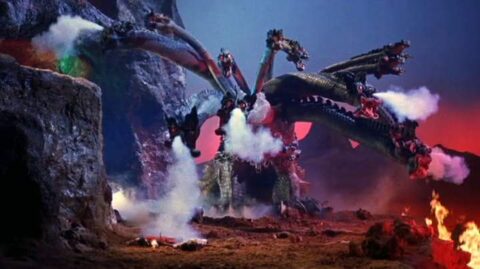
After this things really kick into high gear as Sindbad and company journey towards the tower which contains El Kerim’s heart through a forest of death – a gorgeous set this and one that’s beautifully lit in an almost Mario Bava-esque fashion – a rocky land of fire and up the tower while being gradually polished off by the many perils on offer. Throughout this film, for every weak effect there’s a strong one and one can still admire the effort in the weak examples. When Galgo stretches one of his arms so it becomes incredibly long and goes outside and into the next building so he can steal something from El Kerim, we love the cool concept even if the arm seems to extend unnaturally and the hand looks very solid. When Galgo picks up a tiny Jana, the shot has precise dimensions and excellent matting despite the lousy quality of some of the matting elsewhere, not to mention bits like when romantic music plays over a scene transition but we transition to a shot of the sea which is extremely grainy. Was anything actually shot in real waters? Some giant crocodiles looks rather impressive at first and the device of having them pushed right into the camera almost overrides the obviousness that they’re on rollers. A ten-headed Hydra isn’t served too well by the scene it features in, with it being overcome rather too quickly just like most of the creatures encountered by the likes of Hercules, Samson and Ulysses in the countless Italian peplums of the same time. But, even though we can sometimes see the strings, it’s a well operated creation with necks which move fairly naturally and almost Oriental-style faces. It’s interesting that this and Jason And The Argonauts share two similar scenes; there’s also an early ship trek through dangerous rocks, though dolphins [!] disappointingly save the day here before any clashing rocks or sea gods can go into action.
The actors are superimposed over desert footage for one scene, but then again Sinbad And The Eye Of The Tiger hardly ever seemed to have its actors visit the locations either. It looks like the interiors have many of the same pieces rearranged, yet the gaudy red carpets, purple ceiling and golden dragons have a garish charm and the costumes match them. Matte paintings and normal paintings comprise much of Suristan, the arena being surrounded by them, though the work is very good and in some shots may not have been obvious before DVD. Special effects technicians Tom Howard, Karl Baumgartner, Augie Lohman and Lee Zavitz did their best with what they had. I try not to criticise effects in cheap films too much these days, though am still happy to let rip on things in expensive productions because there’s far less excuse for the effects to be bad. The budget for Captain Sindbad was supposedly around $600,000 which is significantly less than that of The 7th Voyage Of Sinbad six years before. And it’s not as if this film takes itself that seriously; it’s rarely properly comedic except for some of the Galgo scenes and a classic moment when The Hand does a “Uhh-uhh” finger wag at Sindbad, yet it does exist on the edge. And nor is it as if the effects are the only notable aspect. Pedro Armanderiz, who the previously year had also played a character called Kerim in From Russia With Love, is a fantastically hissable villain, properly arrogant and evil, making the very most out of lines like “the people are scum”. He sadly committed suicide one day before the American premiere. Guy Williams is properly dashing as Sindbad, reasonably good with a sword, and clearly a better actor than Kerwin Matthews, John Phillip Law and Patrick Wayne. Heidi Bruhl is a more active heroine than usual for the time and, like a few others, attempts a vague Middle Eastern accent, while Sindbad’s crew include a Viking, a man with a hook, and a black man [though he doesn’t say anything as he’s dumb].
Michel Michelet’s musical score is extremely conventional, showing its dominant elements with his main title piece where we hear a bold fanfare for Sindbad, sinister phrases for El Kerim and a gorgeous if very Rimsky-Korsakov-like love theme, though more complex, Borodin-like music is heard during a pointless but rather interesting [the bizarrely dressed woman descending from a giant spider’s web!] ballet sequence. It’s a rather sad sign of the times that many of today’s kids, weened on the slick Marvel spectacles, would probably find Captain Sindbad far too artificial to enjoy, even if its pacing is really very fast. But I consider it to be a film that could have been a genuine fantasy classic if it had had a decent amount of money spent on it. As it is, for us adults who want to escape for a bit and don’t require things to look realistic, it should both charm and beguile.
Rating: 











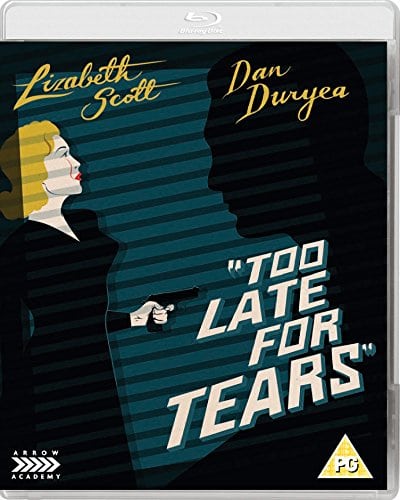

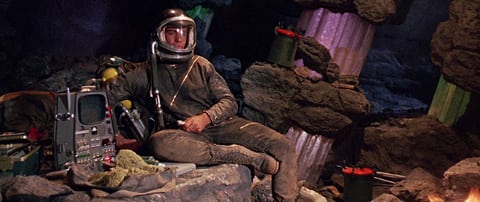
Be the first to comment